Written and photographed by Mary Peachin
Vol. 11 No. 4
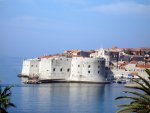 Admiring the stunning view of steep, jagged dolomite and limestone karst cliffs towering above the Adriatic’s crystal malachite waters, we listened to melodic chiming of Dubrovnik’s cathedral bells echoing above the lapping waves. We were unaware that a rising tide had carried us a 100 yards from the ladder exit of the swim terrace at the Villa Argentina hotel.
Admiring the stunning view of steep, jagged dolomite and limestone karst cliffs towering above the Adriatic’s crystal malachite waters, we listened to melodic chiming of Dubrovnik’s cathedral bells echoing above the lapping waves. We were unaware that a rising tide had carried us a 100 yards from the ladder exit of the swim terrace at the Villa Argentina hotel.
While the chill of the Adriatic Sea was invigorating, we were eager to stroll into the ancient, walled city. Swimming against the current, we dressed and made our way down the cobblestone street.
 Croatia’s most captivating city, impenetrable and indestructible since the 7th century, was severely damaged during the 1990s civil war. Now, fully restored, terracotta tiled roof tops and smooth marble passageways weave between white limestone buildings.
Croatia’s most captivating city, impenetrable and indestructible since the 7th century, was severely damaged during the 1990s civil war. Now, fully restored, terracotta tiled roof tops and smooth marble passageways weave between white limestone buildings.
Cruise ships shuttle passengers to a landing near Pile Gate, a 1537 drawbridge. Couples stroll the Place promenade, spend hours in outdoor cafes licking a gelato or sipping an espresso, tour historic attractions, browse in small shops, or haggle with embroidery, jewelry, and souvenir sidewalk vendors.
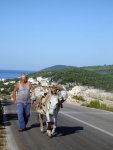 Our plan was to explore the serpentine Dalmatian coastline by bus and ferry. We quickly learned that Croatia’s tourist season abruptly ends on October 1st. Ferry departures connecting many of Croatia’s 1000 or so islands would now dictate the time and direction of our 16 day northerly odyssey to Zagreb.
Our plan was to explore the serpentine Dalmatian coastline by bus and ferry. We quickly learned that Croatia’s tourist season abruptly ends on October 1st. Ferry departures connecting many of Croatia’s 1000 or so islands would now dictate the time and direction of our 16 day northerly odyssey to Zagreb.
Our journey was now dependent on semi-weekly rather than twice daily ferry departures. Many hotels and restaurants were closed, cultural events and festivals were over. We didn’t want to lose time waiting for ferries, so we rented a car.
Departing Dubrovnik, the two lane road hugs coves overlooking the Adriatic Sea. Stately 400-hundred year old Cypress, ripening fruit trees, grape-laden vineyards, and olive groves line the highway. Families were busy tending fields or harvesting grapes. The landscape and air glistened. Roadside litter was non-existent.
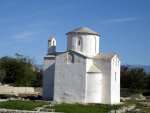 Thirty seven miles northwest, the settlements of Ston and Mali Ston, once an important salt-producing area, is renowned for its locally farmed oysters and mussels. The Kralj family serves up the freshest in their family restaurant, Kapetanova Kuca. It was a delicious lunch break.
Thirty seven miles northwest, the settlements of Ston and Mali Ston, once an important salt-producing area, is renowned for its locally farmed oysters and mussels. The Kralj family serves up the freshest in their family restaurant, Kapetanova Kuca. It was a delicious lunch break.
A typical Jadrolina ferry between islands is like a drill. There are no reservations. A few minutes before departure, the ticket office opens. After purchasing passenger tickets and one for the vehicle, the parking queue, at precisely the scheduled departure time, follows one another to the end of the dock then up a narrow ramp. Cars and trucks are wedged on the boat like sardines. Larger ferries have salons, and perhaps, Croatia’s best coffee.
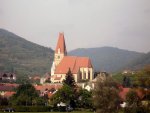 Most Dalmatian coast touring is highlighted by ferry hopping to islands like Mljet, Korcula, Viz, Brac, and Hvar, just to name a few of the more popular, inhabitated islands.
Most Dalmatian coast touring is highlighted by ferry hopping to islands like Mljet, Korcula, Viz, Brac, and Hvar, just to name a few of the more popular, inhabitated islands.
Korcula is one of the larger Dalmatian islands. Unwalled, the architecture of the smaller city is similar to that of Dubrovnik. Korcula claims to be the birthplace of Marco Polo. Ordinary hotels near the old town are expensive. Throughout the country, families rent rooms, which is where we spent the night in Korcula.
Not only is Croatia stunning, its people are warm and friendly. Men are tall, women are sophisticated and stylish. It’s always possible to find someone who can communicate in English. The country, accommodations, restaurants, and restrooms, is clean. The majority of independent travelers we encountered were Brits, Germans, and Aussies.
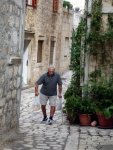 After ferrying from the village of Drenik to Hvar’s Sucuraj, the 80 kilometer hairpin road to Hvar city is one traveled at a snail’s pace. There is not an inch of room for error. Cliffs tower vertically high above the Adriatic. There are no guard rails, not even a shoulder. Like most of Croatia, road signs are infrequent with even fewer distance markers. With only one road up the coast and crossing islands, you arrive when you arrive. On the western tip of the island, the city of Hvar’s, marble streets and stone buildings surround a small harbor. Many visitors come to kayak, scuba dive, sail, raft or explore historic attractions.
After ferrying from the village of Drenik to Hvar’s Sucuraj, the 80 kilometer hairpin road to Hvar city is one traveled at a snail’s pace. There is not an inch of room for error. Cliffs tower vertically high above the Adriatic. There are no guard rails, not even a shoulder. Like most of Croatia, road signs are infrequent with even fewer distance markers. With only one road up the coast and crossing islands, you arrive when you arrive. On the western tip of the island, the city of Hvar’s, marble streets and stone buildings surround a small harbor. Many visitors come to kayak, scuba dive, sail, raft or explore historic attractions.
Hvar’s history dates back to its 4th century BC discovery by the Illyrians. Two centuries later, Hvar was conquered by the Romans. Slavic tribes settled the island during the 7th century. Today, its architecture is both ornamental and Gothic.
In 1664, Hvar’s city fathers welcomed the sisters of St. Benedictine. Cloistered, today, they support themselves by patiently stripping the spines of the agave to weave delicate lace.
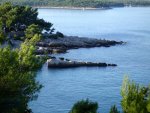 Octopus and truffles. It’s hard to get a bad meal in Croatia. Both seafood and meat lovers will rejoice. Fish are classified as first (wild) and second (farmed) class. Many meals are preceded by an amuse bouche and conclude with a glass of grappa. McDonalds and a few other international chains exist in only several large cities like Opatjia and Zagreb. With coffee typically bad, we would have welcomed a Starbucks. On the other hand, hot chocolate made with real syrup and a dollop of whipped cream was sinfully delicious. There are fast food hamburger stands or “slow food” typical restaurants. In most places, a frosty draft beer is a better choice than a glass of young wine.
Octopus and truffles. It’s hard to get a bad meal in Croatia. Both seafood and meat lovers will rejoice. Fish are classified as first (wild) and second (farmed) class. Many meals are preceded by an amuse bouche and conclude with a glass of grappa. McDonalds and a few other international chains exist in only several large cities like Opatjia and Zagreb. With coffee typically bad, we would have welcomed a Starbucks. On the other hand, hot chocolate made with real syrup and a dollop of whipped cream was sinfully delicious. There are fast food hamburger stands or “slow food” typical restaurants. In most places, a frosty draft beer is a better choice than a glass of young wine.
On the road again, the ferry to Split returned us to the northern coast of the mainland. During busier times, women with available rooms for rent flashed “apartment” signs as they walk between offloading cars.
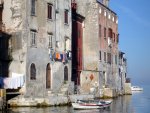 Split, a major gateway and geometric maze, is a booming metropolis complete with traffic jams and stop lights. It is renowned for its Romanesque Diocletian’s Palace, more typical of a fort. It was the emperor’s home until his death in 305 AD. Trogir, a charming village northeast of Split, attracts many tourists wanting to bypass the hectic pace of the city.
Split, a major gateway and geometric maze, is a booming metropolis complete with traffic jams and stop lights. It is renowned for its Romanesque Diocletian’s Palace, more typical of a fort. It was the emperor’s home until his death in 305 AD. Trogir, a charming village northeast of Split, attracts many tourists wanting to bypass the hectic pace of the city.
Zadar is the largest city in upper Dalmatia. Built on a peninsula, it dates back to the 4th century BC. The Greeks, Romans, Turks, French, Austro-Hungarian kingdom, Venetians and more recently, the Yugoslav army battled for it. WWII almost completely destroyed it.
Just east of Zadar is Croatia’s oldest royal village, Nin. Until it was conquered by the Romans, it was a Liburnian settlement. Access to the pedestrian-only town, located in the center of a shallow lagoon, is by footbridge.
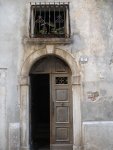 If the city streets of Croatia are clean, the recently opened toll road between Split and Zagreb is spotless. Not a skid mark in sight. Miles-long well-lit tunnels bypass Plitivice National Park, a forest of colorful fall foliage ascending, literally, into the clouds. Exiting onto a local road to Senj, women sat under bright umbrellas selling homemade goat and cow cheese, and honey. Others sold home made olive oil and wine in home style bottles. Roadside restaurants grilled lamb and suckling pig on spits.
If the city streets of Croatia are clean, the recently opened toll road between Split and Zagreb is spotless. Not a skid mark in sight. Miles-long well-lit tunnels bypass Plitivice National Park, a forest of colorful fall foliage ascending, literally, into the clouds. Exiting onto a local road to Senj, women sat under bright umbrellas selling homemade goat and cow cheese, and honey. Others sold home made olive oil and wine in home style bottles. Roadside restaurants grilled lamb and suckling pig on spits.
Picturesque Rabac, a fishing village about halfway down the eastern coastline of Istria, hugs a snug cove. “Ah, Istria, this land is about olive oil, wine and truffles,” Persic Vladimir, owner of Villa Annette proudly stated as he embraced a plate of three white truffles, worth a mere $500.00 Euros.
During WWII, Italian dictator Mussolini drained a lake in the village of Plonin to plant trees. Istria may have lost a beautiful resource, but, ironically, Mussolini’s destruction resulted in the cultivation of truffles, a delicate fungus that sells for $2500 Euros a kilo. Truffles grow on tree roots. Dogs are trained to locate and dig them out.
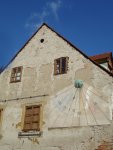 At the southern tip of Istria, Pula’s primary attraction is a 1st century Roman amphitheatre. Centuries ago, gladiators battled as 20,000 spectators watched from two rows of stone seats. A smaller version of Rome’s Coliseum, most of its 95 foot wall is still intact. During the Middle Ages, many of the seats were destroyed for use as building materials.
At the southern tip of Istria, Pula’s primary attraction is a 1st century Roman amphitheatre. Centuries ago, gladiators battled as 20,000 spectators watched from two rows of stone seats. A smaller version of Rome’s Coliseum, most of its 95 foot wall is still intact. During the Middle Ages, many of the seats were destroyed for use as building materials.
Northeast of Pula, the 7th century port village of Rovinj has maintained its medieval appearance. Each daybreak, fishermen arrive with their daily catch. Locals scurry to the open market to buy the fresh fish and produce.
Rovinj’s steeply worn marbled streets are too narrow for vehicular traffic. The exception is several hotels shuttling guests from parking lots outside the old town. For more than a hundred years, exactly at noon, a cannon is fired from the Lotrscak Tower in Zagreb. The capital city is the political and economic hub of Croatia. Istria and the Dalmatian coast dazzle so it is disappointing to see garbage on Zagreb streets and unsightly tagging on walls. The cultural hub, moving at a frenetic pace, is a “graffiti city.”
If you can look beyond this graffiti, while dodging non-stop electric trolleys barreling curbside in both directions, Zagreb offers hidden charm and colorful baroque architecture.
Little is known about the city’s early history. Mongols destroyed Zagreb in 1242. In the 15th century, it emerged as Croatia’s capital after the Turks captured most of the country.
Ban J. Jelacic Square is the gateway to the Upper Town’s outdoor markets of Dolac. Flower vendors dominate the fruit and vegetable vendors, and an indoor fish market.
“Ah,” as Persic Vladimir said, “Istria is about olive oil, wine and truffles.” He easily could have included the entire country in his passion. Croatia is a beautiful landscape with a fascinating history. It offers wonderful cuisine. The Croats are friendly and honest hosts. Watch out, Croatia! Americans will soon be coming to visit your wonderful country.
If you go: Gateway cities to Croatia are Dubrovnik, Split, and Zadar. All are serviced by multiple airlines.
Some tips: Croatia is not disable friendly. Marble streets can be slippery, especially when wet. Wear non-skid shoes. Be prepared to climb stairs and hillsides in each village, plus uneven steps through doorways and bathrooms. Many attractions, shops, and restaurants are closed on Sunday. Menus and importance signage is printed in four languages: Hrvatska, German, English, and Russian. Mosquitoes are pesky on some islands and beach towns. Bring insect repellant. If air-conditioning is a priority, make an inquiry. Some hotels do not have air or elevators. Finding a non-smoking room or restaurant area is a challenge. In early October the weather was continually sunny with temperatures in the 60s. Croatia’s is less expensive than other E. U. countries.
Hotels:
Dubrovnik, Grand Villa Argentina, While not as glamorous as the old town’s Pucic Palace, it offers a spectacular view of the walled city and Adriatic sunsets. It is a 10-minute walk outside the gates. www.gva.hr
Hvar: Hotel Podstine, About 25 minutes from the city, this small romantic hotel clings to a cliff overlooking a private cove, www.podstine.com
Zadar: Hotel President, A small luxurious 27 room family-owned hotel on the outskirts of the city. www.hotel-president.hr
Rabac, Istria: Villa Anette. This four-star contemporary suite property has a distant view of the Adriatic from its hillside location. www.villaannette.hr
Rovinj: Hotel Villa Angelo D’Oro, Overlooking St. Euphemia cathedral, the 17th century 24 room property was originally the Bishop’s home.
Zagreb: Palace Hotel Built in 1907 this elegant property is a centrally located charmer. www.palace.hr
Apartments: Throughout the country families rent rooms or apartments. Go to www.croatianvillas.com to rent apartments, villas, yacht charters, and car hires. Green Vacations. Spend several days on a farm.
Restaurants:
Korcula: Konola Maslina, Ask directions to this small family-owned restaurant located in the outskirts.
Hvar: The city is so easy to navigate that its street are not named. Ask directions to Luna and Macondo, both excellent restaurants are located a few blocks from main square, Trg Sveti Stjepana.
Zadar: Located in the President hotel, Vivaldi’s cuisine is gourmet. Engraved silver, glassware, and china combined with impeccable service make the place classy.
Rabac: Nostromo, Small, with a waterfront view, this restaurant serves delicious fish, seafood, and meat topped with truffles. www.nostromo.hr
Villa Annette, the modernistic hotel restaurant shaves a generous amount of fresh truffles on your entree. www.villaannette.hr
Livade: Restaurant Zigante, In the Mirna river valley, Zigante is a gastronomic experience that includes shaved black truffles on every dish including gilthead fish carpaccio. The restaurant holds a Guinness World Record for owning the largest truffle. www.zigantetartufi.com
Pula: Valsabbion is a family-owned restaurant located on the Verudela Peninsula. It is considered one of Croatia’s finest. www.valsabbion.hr
Zagreb: Hotel Regent Esplanade, Built in 1924, this luxury hotel, located next to the train station, is the choice of most Americans. It offers both fine and bistro dining. www.regent.com
Nokturno, the popular lunchtime bistro is in the upper town.
Kavarna Boban, young adults mingle to enjoy Italian food in this attractive brick-vaulted ceiling restaurant. Skalinska 4, tel. 48 13 394
For further information: Zagreb Tourist Information, www.zagreb-touristinfo.hr add Croatia Tourist Board
